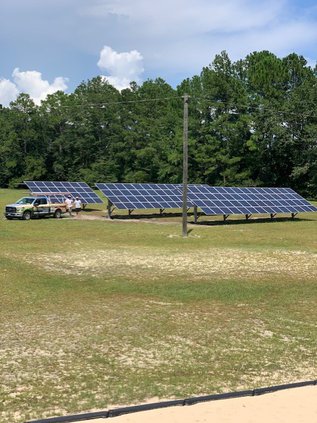The students at Lyman Hall Elementary will get a hands-on approach to learn about green renewable energy and solar power after the Liberty County School System installed a 25-kilowatt ground mount solar power system on campus. The project is near completion and installed by local solar power company Coastal Solar in Hinesville.
“We feel very privileged and honored to do it,” Coastal Solar Senior Systems Consultant Candler Boyd said. “It is especially gratifying to me and (Owner) Clay (Sikes).”
Boyd and his wife Brenda are both former educators with the LCSS. Boyd was also heavily involved in coaching and administration for several years. He said his children and Sikes’ children all attended schools in the LCSS.
“So, it gives us a lot of pleasure to introduce solar energy to the young people at Lyman Hall,” Boyd said.
The LCSS approved the project during their June 9, board meeting. Coastal Solar had the lowest bid at $69,569.87 and were awarded the job. The Georgia Environment Finance Authority (GEFA) awarded the LCSS a grant that covered half the cost of the installation ($34,784.93). The remainder of the cost will be paid from the LCSS Operating budget.
Boyd said the project includes a kiosk in the lunchroom that has a big screen TV so the kids can watch what the solar array panels and experience real-time data reporting.
“Kids will learn from the cutting-edge technology and will also learn about renewable energy and its positive environmental effects,” Boyd said. “It is becoming evident that there is some change going on in the climate and we want to do everything we can to preserve the delicate ecological balance. I have grandchildren, Clay has grandchildren and we are becoming more and more aware of how important it is to keep and if at all possible, improve our environment for generations to come.”
Boyd said the system will generate around 39,000-40,000 kilowatt hours each year for a value of approximately $3,900-$4,000 in energy savings. The solar panels will offset approximately 651,896 pounds of carbon dioxide per year. This is the equivalent of planting 7,950 trees.
LCSS District STEM Coordinator, Kim Boucher said they’ve created lesson plans for each class grade.
She said kindergarten students will generate questions regarding what time of day the solar panels generate the most electricity. The students will investigate and collect data to get answers to their questions and create models to demonstrate findings.
First graders will formulate questions regarding how different types of weather impact the solar panels’ collection of energy. Boucher said the students will learn to track weather patterns in tables/graphs and annotate energy collection. The students will analyze data to determine which weather patterns generate the greatest energy collection.
Second Grade students will learn how the sun’s position effects the way the solar panels generate energy collection. Students will represent the data they collect in graphs/tables that show energy collection by the solar panels and where the sun was positioned on hourly intervals. Students will design solutions to shadows cast by fixed objects that may interfere with the solar panel effectiveness, Boucher said.
Third Graders will learn about heat and temperature and its effect on the collection of solar power energy. Boucher said students will use thermometers to determine daily outside temperature and surface temperature of the solar panels in both Celsius and Fahrenheit. The students will track energy data as collected by the solar panels in charts/graphs and use the data collected to recommend solutions that will increase/decrease warming effects on the solar panels.
Fourth Grade students will use weather instruments to track rain and wind daily, and record energy produced by the solar panels. They’ll look at weather maps to make predictions of the next day’s solar panels energy collection. Students will learn whether different cloud types have different impacts on energy collection and track cloud data using the Globe Observer App.
Fifth Grade students will determine whether solar panels’ energy collection is an example of naturally occurring electricity or human-harnessed energy and provide evidence and reasoning for their claim. Boucher said students will design simple circuits in future collaborative partnerships with electric company to build circuits. Students will determine how many circuits they can create using energy captured by the solar panels in a given time period. Students will identify conductors and insulators of electricity both in their simple circuits and within the solar panel and will further identify ways to reduce energy consumption within their class, home, and school.

